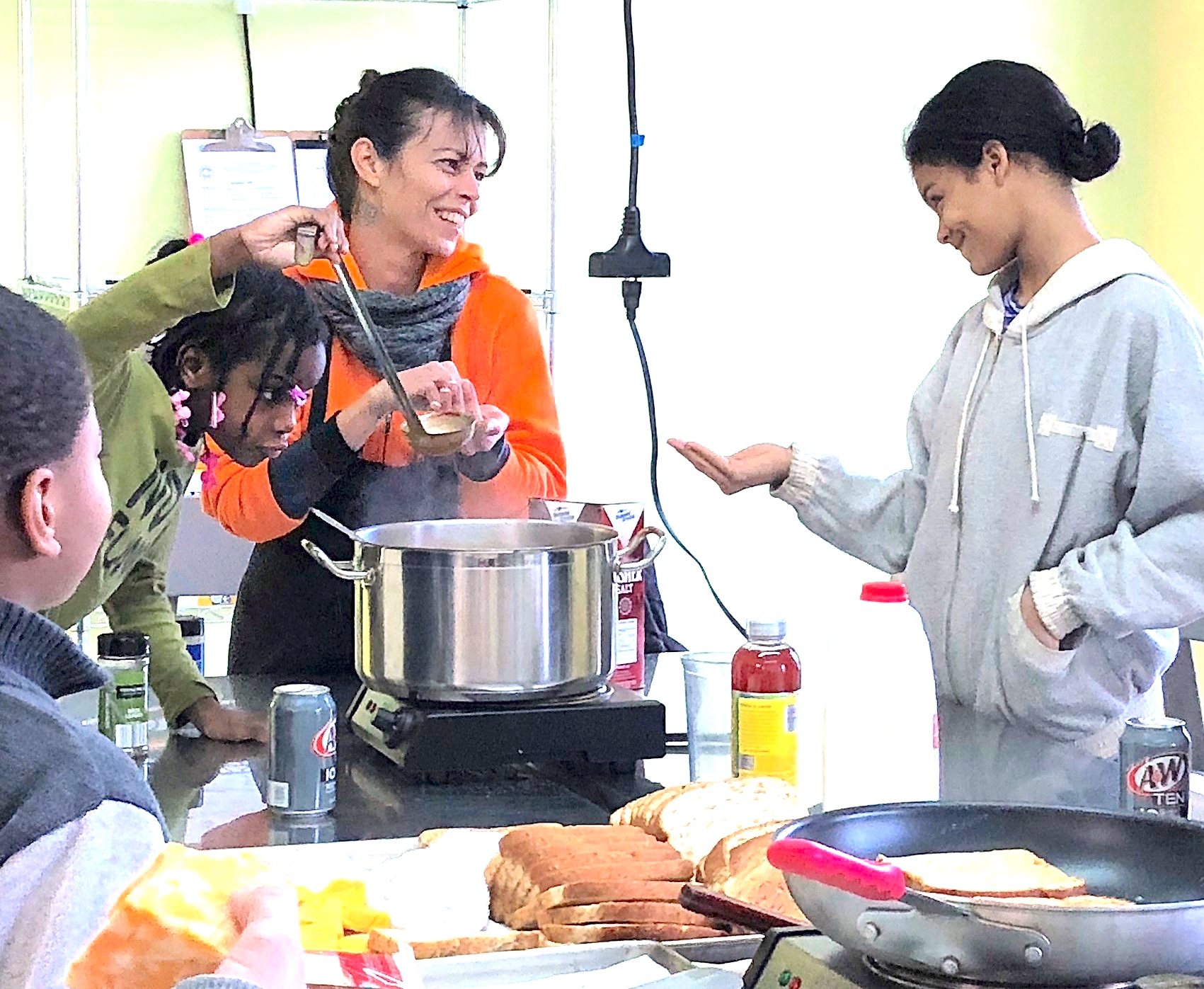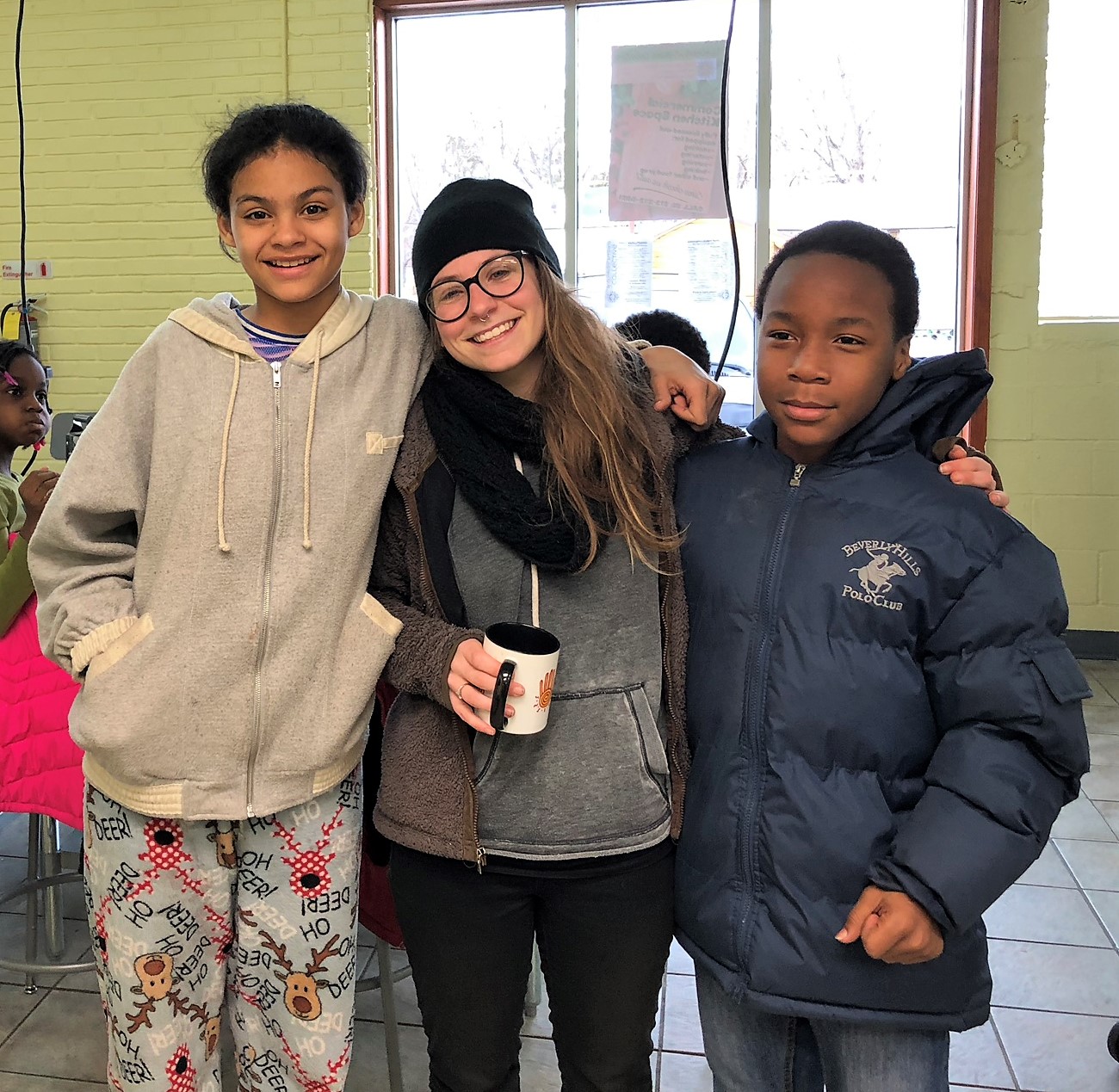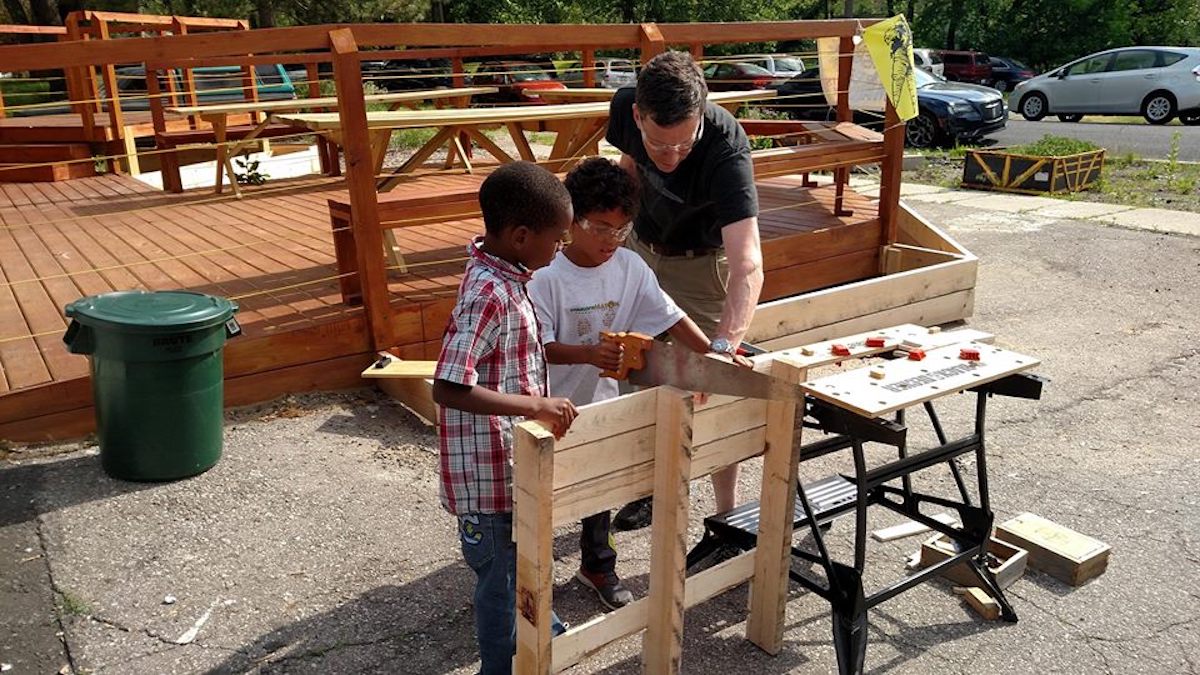Brightmoor Neighborhood Sows Seeds of Sustainability

On Fenkell Street on Detroit’s northwest side, in the open expanse of residential abandonment and corporate disinvestment, the Brightmoor Artisans Collective (BAC) protrudes from the landscape of gas station, car wash and liquor store like a vibrant bloom pushing its way through the cracked sidewalk, a salient reminder that life and beauty find a way. Positioned within roughly 4 square miles of one of Detroit’s poorest neighborhoods, the BAC is an identifying hub of resilience and hope, a space belonging to and shaped by the community, empowering them as neighbors, artists and farmers.
Farmer isn’t a term one would expect to hear a stone’s throw from Telegraph Road and the I-96 Freeway. Yet, as in many other marginalized Detroit communities, urban agriculture has taken root here, neighbors cultivating the joy of gardening into a response to serious community challenges: blight, poverty, crime and a lack of local, healthy food options.
The Brightmoor Artisans began in 2014 as an offshoot of the neighborhood nonprofit, Neighbors Building Brightmoor (NBB). The collective artisan space opened in 2015 and was designed as a response to the community’s surplus of freshly grown produce with the intention of “creating and maintaining a safe space where community members could creatively work and learn together to process, market, and consume affordable, healthy food.” Hundreds of gardens, some rising to the category of small farm, have populated this near “food desert” as part of a movement which began in 2006 with one single garden.
The Brightmoor Youth Garden, led by Riet Schumack, and neighbors Carole Hawke, Sheila Hoerauf and their families, was created to combat the trash dumping, gang presence, drug trafficking and prostitution that had ravaged the Detroit neighborhood. Schumack’s love of gardening and desire to create a safe and nurturing space for children in the community while living as their neighbor, compelled her and her husband Mark to move from their comfortable home in a well established neighborhood to a house on Greyfield Street just south of where the BAC now stands. Hawke and others soon followed with similar desires to live intentionally with others, to transform blight into beauty, to use vacant space for urban homesteading, and to care for and empower neighborhood youth.
“Our move to Brightmoor was a calling,” Shumack explains on the Oprah Winfrey Network’s (OWN) “Super Soul Sunday” short documentary, “When we came, it was not a safe place for children. There were too many people who were allowed to do illegal things so it was very scary. You would never see anybody outside.” She continues,”Ultimately blight is an expression of the breakdown in human dignity and the breakdown in community. Poverty in itself doesn’t cause blight. It’s when people lose hope and stop caring.”
The Brightmoor Youth Garden began on three city lots and expanded over time to fill double that space. For the youth involved in the program, the garden belonged to them, with adults helping to provide learning opportunities and resources. “Owning something is different than working for somebody else,” Shumack says in the OWN documentary, “and I think it does something for your self-esteem.” She continues, “They’re learning everything about life. They’re learning about reality, they’re learning about hard work, about patience, waiting for things, planning your time, showing up, working in teams.”
The kids cleared debris, prepared garden beds, weeded, harvested, weighed vegetables and brought them to market where they earned money for their hard work. They took care of goats and chickens, animals they may have never otherwise interacted with. Youth participants captured in the OWN film said they were no longer scared to walk down the street, that the neighborhood was more peaceful and that they now felt a connection between people living there. The original Brightmoor Youth Garden brought neighbors out of their houses into green spaces, planting seeds of hope and vision, and igniting a movement that now encompasses six and a half acres of local farms and gardens.
As beautification and sustainability efforts increased, Neighbors Building Brightmoor was created as an official presence, one that could make clear the intentions set on the neighborhood and seek financial and volunteer support to do so. The invitation from NBB to new neighbors remains today, “We won’t do anything for you, but would love to do it with you. Tell us how to help you.”
In addition to the youth garden, the neighborhood worked intergenerationally to aggressively clean up blight, board up houses, and create additional community spaces. Brittany Bradd, director and kitchen manager of the BAC and current vice-president of NBB, recalls how kids in the community painted murals on the wood used to board up houses. “You wouldn’t think something small like that makes a difference, but we see it over the years, people are more inclined to leave it up. It’s like a pretty thing, even if the house is questionable. The kids like it. When they walk by they can say, ‘I painted that with my cousin.’ It becomes a more relatable thing.”
In this way, visual art began to have a strong presence in the neighborhood from the donated talents of local artists to those of community volunteers. The slogan, “Be the Change You Want to See in the World,” began to show up on multiple sealed up properties along with other colorfully painted messages of hope. As a larger art project, NBB removed the sides off an abandoned and dilapidated house, leaving only its roof and frame, while vibrantly painting its insides to create a neighborhood stage for community events such as the Fall Harvest Festival, still in use today.
Through these labors, fifteen blocks, now referred to as the Brightmoor Farmway, have been relieved of crime and transformed to spaces of creativity and life. Though the neighborhood is far from perfect, the advantages of open lots, access to the Rouge River, and the large nearby Eliza Howell Park are being more often enjoyed as country luxuries within city life than feared as heightened elements of danger. Hawke, who believes the original neighborhood has stabilized, has moved further into Brightmoor where she feels there is a greater urgency. “There is a lot functioning over there,” she explains, referring to the BAC neighborhood, “people of my education level and skill set.” She says her heart is to be where she’s needed. Though her new community brings greater challenges, Hawke is taking what she has learned, planning a community garden on a nearby lot that was just granted permission to farm. She says her favorite part of Brightmoor living has been “Seeing the teenagers catch a vision and really take pride in what they’re doing. Detroit is a place where, if you are a kid and you are involved in stuff like this, you really see a physical impact on where you live.”
Bradd, who is often picking up and dropping off neighborhood kids to remove barriers to having them at BAC activities, also believes that youth play a vital role in restoring communities. “You see the change that can happen even with parents just by having their kids involved in something in the community,” she says.
The Artisans Collective, which Bradd oversees, is a unique space: part community center, part kitchen and food processing facility. The program activities are all inclusive to the youth in the neighborhood. Respecting and investing in the children here continues to be an important goal for this community. From book clubs to cooking classes, dance and yoga classes, to homework help, and computer and artisan workshops, activities are open, free, and mainly intergenerational. The health and creation space and kitchen classroom are available for private rental as well but Bradd says the rule is, “If you don’t charge our neighbors, we won’t charge you.” Free cooking classes are taught by farmers and kitchen renters, neighbors, and partners like Motown Meals, who teach a weekly class as well as prepare a community meal free to residents one Sunday a month.
Bradd says the classes are sculpted around whoever shows up. They have a popular dance class which is taught by Brion, a 12-year-old boy who has held the responsibility of making schedules and lesson plans for the Monday night class he teaches to 15 students. The book club, which started in chairs in the parking lot during the summer of 2015, meets year round and is a community favorite. “Right now we’re reading Holes,” Bradd says. “And it’s so much fun. Every week we read a couple of chapters and when we’re done we’ll roll out our popcorn machine, make popcorn and watch the movie.” She says if real young kids show up, they love to listen along if they can’t read yet and much older kids will engage by taking turns reading to the younger ones and doing voices. “It’s just cool because it’s whatever they want it to be.” she says. “It’s their programs. We just manage the facility and we have the resources for them.”
The kitchen and processing area in the collective is a rentable space and a main focus in supporting the farming and gardening community here. Bradd says that as the neighborhood began to stabilize and residents switched away from survival mode, NBB started to ask themselves what was next. This question led to the formation of the Brightmoor Artisans Collective, who envisioned a space in which to connect and support the community as it sought to strengthen its own livelihood. The collective’s kitchen and food processing spaces were created to further increase the economic capacity of local farmers and food entrepreneurs.
Bradd said she came to the neighborhood because she was tired of renting but couldn’t afford to buy a house. She discovered WWOOFing (Worldwide Opportunities on Organic Farms), a work exchange program between farmers and volunteers which landed her at Knucklehead Farms, run by Riet Schumack. She had come to be a livestock manager for Schumack’s goats (before they were deemed illegal) and to oversee her WWOOFers as she worked to build her own tiny house in which to live and travel inexpensively. “I was planning on leaving ultimately,” says Bradd. “I mean, I was planning on hanging out and helping as much as I could, but then going and travelling and exploring as many farms as I could see. But by the time my house was done, I was so connected already, so attached to everything that was happening here, and to Riet.” She adds, “The character that comes out of people in these areas is so much more real than people I’ve encountered anywhere else.”
Bradd purchased her own extensive lot on the same foreclosure auction that the Brightmoor Artisans bought their triple storefront collective. In addition to running the BAC, she now lives in her tiny house while restoring the residential home on the property and working the adjacent Graydale Farms, an acre sized vegetable farm which donates all of its produce to supply the BAC cooking classes. The largest farm in the Brightmoor community is Beaverland Farms, a 2 acre homestead and for-profit fruit and vegetable market farm. The rest vary in size down to small front yard or side lot family gardens.
Since Shumack’s retirement from the BYG, Bill and Billie Hickey lead the Youth Grow Brightmoor garden on the lots behind their house. They currently work with 8-12 neighborhood youth ranging from ages 7-17 that grow and sell their produce at the Fenkell market in the parking lot of the BAC as well as at Eastern Market. Billie Hickey says the kids sold over $1400 worth of produce last season, each receiving profit based on their individual hours of participation.
The Hickeys say they went from living in a big Detroit house with a small lot to a small house with a large space for gardening so that they could live more sustainably and more connected with their neighbors. Billie Hickey says the challenges of living in Brightmoor have been sharing in the lives of neighbors, including youth, who struggle with so many issues related to poverty — low-paying jobs, lack of transportation, home foreclosures and discrimination.
The BAC hosts a farmers market on Friday evenings from June to October to help provide affordable fresh food and increased income sources. Within the kitchen and processing center, income source is expanded for growers as well. Bradd explains how if 100 people harvest tomatoes and they are all trying to sell them at the same time, that doesn’t work. But if one person turns them into sauce, another salsa, another paste, one dehydrates, and another makes soup—well now you have a variety and things that actually have a shelf life. “The minute you make a value added product out of produce,” she explains, “it immediately increases in its value. But you can’t do that and sell to the public out of your home.”
Bradd says the amount of red tape that exists in selling food products results in many people who are without support unable to do so. She says the BAC aims to help remove these barriers by providing temperature regulated storage, affordable processing space, and help with licensing.
“A lot of people here have time and not money,” she continues. “Our membership is $45 a year or four and a half hours of pre-approved service tasks. When you’re a member, you can enroll in our work trade program.” She explains that in the program, every hour of service earns $10 of credit that can be used toward toward kitchen rentals, market vendor fees, or to make purchases at the attached cafe. They can use it for business, for sales, or for food.
The Artisans Cafe is the latest piece to the collective and will have a soft opening later this month and a grand opening at the first market in June. While providing healthy and affordable food and drink, its focus is on educational opportunity for youth ages 13-24 who are part of the Youth Entrepreneurship Program. Through the program, teens receive hands-on work experience as they work part-time in the cafe, plan and prepare the menus, attend field trips and weekly workshops, and receive a stipend and tips for their cafe hours. On completion of the one year and nine month program, the BAC hopes to have equipped youth with everything they need to know to start their own food business — culinary skills, business basics, financial literacy, garden skills, and community engagement. The final level prepares youth to be able to teach and transfer knowledge by bringing them into the classroom to teach new students what they have learned. Bradd says that regardless of whether or not participants open their own food business, the skills taught in this program will transfer into many successful job situations.
Additional neighborhood alliances and dedicated faith communities are working for and calling others into action over the Brightmoor neighborhood. Yet, the changemakers in Brightmoor know nothing will be coming easy to this Detroit community. As the collective neighborhoods continue to fight issues of poverty and abandonment, each neighbor, each community investor makes a vital difference. Just as Riet Schumack could not have known the sprouting effects one garden could have, we are hopefully yet to see the extent of how this community, devoted to its land and its youth, may continue to grow and flourish.


